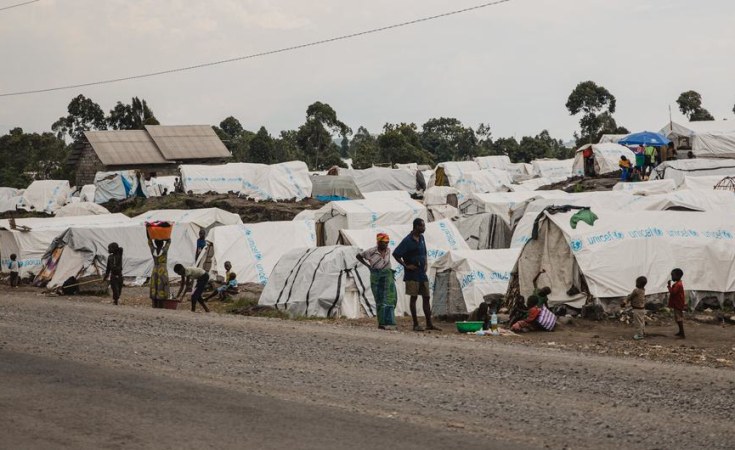Over the last few days, Catherine Wambua-Soi, Al Jazeera's producer in the region, has enjoyed unfettered access to government-controlled areas in eastern DR Congo, notably the town of Sake, North Kivu Province's capital, Goma, as well as the zone right next to the Congolese border with Rwanda. She's interviewed internally displaced people in the camps surrounding Goma and had members of her camera crew join a FARDC (the DR Congo's national army) patrol in Sake, a town about 20 kilometers from Goma that's recently become the focus of anti-M23 armed activity.
ALSO READ: Former FDLR deputy president on how genocidal militia was formed
As a DR Congo observer, I found her reporting unsurprisingly simplistic and driven by the same old tired narratives, that is; that the conflict in eastern DR Congo was solely fuelled by minerals like coltan, that the refugee crisis was a result of M23's 2021 offensive, and that Rwanda was behind the rebellion.
However, at a fundamental level, I didn't have a major gripe with her reporting because I understood that, as an Al Jazeera staff member, she had an editorial policy to adhere to. And in the case of the conflict in eastern DR Congo (and unlike their reporting in the Middle East and North Africa), Al Jazeera's editorial policy, mirroring that of the BBC, CNN, and New York Times, was based on seemingly agreed-upon narratives that I mentioned earlier.
ALSO READ: US, France embolden Tshisekedi in war stance
What I COULD NOT allow to stand, without challenge, was her and her news organization's attempt to sanitize the 'Wazalendo'. In a news report titled 'Wazalendo fighters join government forces in fight against common enemy' released yesterday [February 26] morning on Al Jazeera (and then posted on their YouTube channel), Wambua-Soi did all she could to transform the Wazalendo into heroes, nay, freedom fighters even.
Reporting that they (Wazalendo) had "put aside their differences to help government forces in their goal to defeat what they see is a common enemy," Wambua-Soi noted that thousands of these militiamen/women had been deployed to "boost the number of soldiers on the front line".
For those who are confused by the moniker 'Wazalendo', let me share a brief background.
Eastern DR Congo is home to over 130 militias, both local and foreign. The local ones include groups with names like Codeco, Mai Mai, and Nyatura. The foreign groups include the Ugandan ADF (operating in Ituri), the Burundian Red-Tabara (operating in South Kivu), and the Rwandans, of FDLR (operating in North Kivu). All these groups have been operating in eastern DR Congo for decades, raping, pillaging, and killing. The UN, through various Groups of Expert reports, and various other NGOs, have documented many of the crimes that they have committed.
ALSO READ: DR Congo's Rwandophone question: What US govt, SA, Tanzanian leaders have said
Instead of arresting these militias (and punishing them for their human rights abuses), what the DR Congo government decided to do was sanitize, arm, incorporate them into the national army following the M23 rebellion that resurged in 2021, and direct them to fight M23. Actually, for those who don't know, it was the Congolese government, through spokespeople like Patrick Muyaya (the communication minister), Christophe Lutundula (the foreign minister), and Georges Nzongola Ntalaja (Permanent Representative to the UN) who christened these killer militias Wazalendo (Swahili for 'patriots').
Interestingly enough, Wambua-Soi actually acknowledged that these Wazalendo were extremely problematic, admitting that "some commanders have been accused of committing human rights abuses and facing sanctions". What she didn't do was explain what these abuses are and who they are directed against.
Noting that the Rwandan government had issues with the makeup of the Wazalendo because the genocidal FDLR was fully integrated into the militia, Wambua-Soi went on to describe the FDLR as a group that was "said (emphasis mine) to have been involved in the genocide". By making the involvement of members of the FDLR in the 1994 Genocide against the Tutsi a 'he said/she said' situation (probably in the attempt to be 'unbiased'), she was treading in very murky waters.
To make matters worse, she then allowed the Wazalendo Deputy Spokesperson, Kitsa Ndoole Tony, to utter falsehoods without challenge. Denying that the FDLR was part and parcel of Wazalendo, he said that FDLR was in DR Congo because they are not allowed back in Rwanda. That was a huge lie.
Anyone who knows anything about Rwanda knows that FDLR fighters, in the thousands, have returned home, over the years. This task, of demobilizing and reintegrating ex-FDLR, is undertaken, even today, by the Rwanda Demobilization and Reintegration Commission at its center in Mutobo, Musanze District.
Wambua-Soi, FDLR is NOT in DR Congo because they cannot come home safely. They are in DR Congo because they want to remove the Rwandan Government by force of arms and recommence genocide!
The most chilling part of the news story was when Wambua-Soi (and her cortege of Wazalendo bodyguards) stood astride Wazalendo bases on hills directly overlooking Rwandan territory. Ending the report by showcasing different types of machine guns, Wambua-Soi notes that they have "new weapons and renewed vigor" and will "push M23 beyond Congo's border or die trying".
Those two final shots brought to life the threats that the forces of peace face. They have to deal not just with a hateful militia force (that is being fortified by FDLR and Tshisekedi's government), in addition to a DR Congo government that is stubbornly refusing peace overtures, they also have to deal with a global media that is not only deliberately blind to the real drivers of violence but also cheerleaders to these very drivers.
The author is a socio-political commentator.


